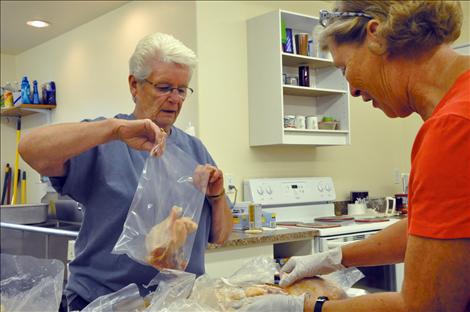Lake County struggles to feed hungry
Hey savvy news reader! Thanks for choosing local.
You are now reading
1 of 3 free articles.
RONAN — Despite living at the doorstep of abundant cherry orchards, a fish hatchery, and wheat fields, residents of Lake County are among the hungriest in Montana.
The problem is mostly invisible to those not working in the intricate network of volunteers that distribute food to the needy; and it stems from poverty and inadequate access.
“The economy in Polson just really never picked up, but you wouldn’t know it unless you work here or come here,” said Merle Parise, board member of Polson Loaves and Fishes. The food pantry reached a record 56 families served in a single day last week, and the number of families coming through the doors is increasing.
“We’ve seen about 15 percent more people this year than last year,” Parise said.
The Ronan Bread Basket has also seen more people coming through the doors, according to director Gloria Kramer. The Bread Basket serves 200 families per month.
While every bit of food helps, the food bank administrators know rations doled out are not nearly enough.
“It will get them along a few more days,” Parise said. “It won’t give them all the food they need.”
Diagrams on the wall of the food pantry describe how to make food stretch, like adding rice and skimping on meat. For many of the food recipients, stretching to make ends meet is all too familiar.
Lake County has the state’s fifth highest rate of food insecurity with 18 percent of adults and 30 percent of children not receiving enough nutrition.
“Food insecurity is when someone doesn’t know where their next meal will come from,” said Diane Mathews of the Montana Food Bank Network in Missoula. On July 31, the network hosted a discussion about hunger with local leaders in Ronan.
Several factors create an environment of food insecurity.
“Low participation in federal programs can be a direct cause of food insecurity and hunger,” Mathews said. Lake County has a 68 percent participation rate of those eligible for SNAP, the federal food stamp program, and 44 percent participation rate for those eligible for WIC, the federal food program for impoverished mothers and children.
Almost all of the recipients are living below the federal poverty level, a category more than 22 percent of Lake County adults and 38 percent of Lake County children fall into.
Many families in the area that were surveyed last summer said they paid rent instead of feeding their families at some point in the past 12 months. Housing costs in Lake County often take much more than the 30 percent of income that is recommended, Mathews said.
“In Lake County, 30 percent of renters and 45 percent of homeowners are paying more than (the) 30 percent guideline,” Mathews said. “They are paying a lot on housing, and that gives them less money to spend on food.”
The county is also classified by the federal government as a “food desert,” which means people regularly have to travel 10 or more miles to get to the grocery store.
“The closest store might be a small grocery store or convenience store where prices are high and fresh food is limited,” said Lorianne Burhop of the Montana Food Bank Network.
But for all the factors working against the hungry in Lake County, there are several others working in their favor.
Availability of tribal health services cuts down on medical costs and lets families dedicate more of their budgets to food.
Two lists — one of individuals and businesses who contribute financially, and one of individuals who volunteer time at the food bank — hang on clipboards in Polson.
“We couldn’t do it without them,” Parise said.
Local farmers also donate excess produce and grocery stores give day-old bread to the food banks. The Confederated Salish and Kootenai Tribe donates fish to the food bank, and recently donated $500 to the Polson Farmer’s Market to match expenditures of anyone paying with food stamps.
Churches often have designated feeding nights for the public. Schools keep their doors open in the summer to make sure children have something to eat.
Still, 6,000 people in Lake County sought out emergency food last year, and local food banks expect that number to continue climbing. The hungriest part of the year, winter, lies ahead.
















